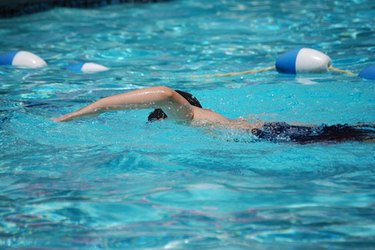
Maintaining water quality in a swimming pool is of utmost important to ensure the health and safety of swimmers. In situations involving certain contaminants, it becomes necessary to raise the chlorine concentration in the pool to levels that are unsafe for swimming. After decontaminating the pool with these high chlorine levels, adding sodium sulfite will decrease the chlorine concentration to a level safe for swimming.
Properties
Video of the Day
Sodium sulfite, Na2SO3, is an odorless white powder that will sink in water and dissolve slowly over time. Sodium sulfite reacts with the chlorine in water, present as hypochlorous acid (HOCl), to produce the salts hydrochloride (HCl) and sodium sulfate (Na2SO4).
Video of the Day
Increased Chlorine Levels
Chlorine levels in swimming pools should fall between 1 ppm and 2 ppm. When potentially hazardous contaminants enter the pool water, the water will need more chlorine than usual for disinfecting the water. Chlorine levels as high as 20 ppm are necessary for thorough decontamination. These situations can include diarrheal contamination and cryptosporidium contamination. Swimmers should not use pools that have chlorine levels in excess of 5 ppm.
Decreasing Chlorine Levels
Once the high chlorine level is maintained for the recommended amount of time to ensure pool decontamination, the chlorine level is quickly lowered using sodium sulfite. Use the manufacturer's instruction to determine how much sodium sulfite to add to the swimming pool. A generalized guideline to follow is to add 2.4 oz. to 10,000 gallons for a decrease of chlorine by 1 ppm.
Precautions
Sodium sulfite is a moderately toxic compound. Exercise care when handling to avoid skin and eye contact. Use a dust mask to avoid inhalation. Keep the container in a secure place away from access by children.